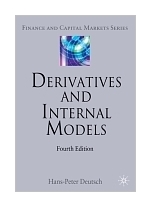Now in its fourth edition, this classic book provides a comprehensive and thorough
introduction to derivative pricing, risk management and portfolio optimization, covering
all relevant topics with enough hands-on, depth of detail to enable readers to develop
their own pricing and risk tools.
The accompanying website http://www.palgrave.com/deutsch contains tried and tested
executable spreadsheets with hundreds of detailed, real world examples
In this book, Dr. Hans-Peter Deutsch provides insight into modern market risk
quantification methods such as variance-covariance, historical simulation, Monte Carlo,
hedge ratios, etc., including time series analysis and statistical concepts such as GARCH
Models or Chi-Square-distributions.
He also shows how optimal trading decisions can be deduced once risk has been quantified
by introducing risk adjusted performance measures and a complete presentation of modern
quantitative portfolio optimization. Furthermore, all the important modern derivatives and
their pricing methods are presented; from basic discounted cash flow methods to
Black-Scholes, binomial trees, differential equations, finite difference schemes, Monte
Carlo methods, Martingales and Numeraires, terms structure models, etc.
All these methods are explained with adequate mathematical rigor and in great detail both
in theory and with the help of hundreds of spreadsheet examples using one consistent
logical approach and notation. This book should enable any bank to create and implement
its own so-called 'internal' risk models.
The new edition is completely updated. Formulations have been streamlined to make the
topics even more accessible and the explanations even more understandable.
HANS-PETER DEUTSCH is Founder and Managing Director of d-fine,
one of the leading financial services consulting firms in Europe. He was formerly a
Partner at Arthur Andersen and Head of Financial Risk Consulting in Germany. Dr Deutsch
holds a Ph.D. in theoretical physics and is author of many publications in the area of
quantitative finance. He is also Guest Lecturer for Mathematical Finance at Oxford
University, UK, and Chairman of the Advisory Board of the MathFinance Institute at Goethe
University in Frankfurt, Germany
Table of Contents
PART I: FUNDAMENTALS
Introduction
Fundamental Risk Factors of Financial Markets
Financial Instruments: A System of Derivatives and Underlyings
PART II: METHODS
Overview of the Assumptions
Present Value Methods, Yields and Traditional Risk Measures
Arbitrage
The Black-Scholes Differential Equation
Integral Forms and Analytic Solutions in the Black-Scholes World
Numerical Solutions Using Finite Differences
Binomial and Trinomial Trees
Monte-Carlo Simulations
Hedging
Martingales and Numeraires
Interest Rates and Term Structure Models
PART III: INSTRUMENTS
Spot Transactions on Interest Instruments
Forward Transactions on Interest Rates
Plain Vanilla Options
Exotic Options
PART IV: RISK
Fundamentals
The Variance-Covariance Method
Simulation Methods
Interest Rate Risk and Cash Flows
Example VaR-Computation
Backtesting: Checking the Applied Methods
PART V: Portfolios
Classical Portfolio Management
Attributes and their Characteristic Portfolios
Active Management and Benchmarking
PART VI: MARKET DATA
Interest Rate Term Structures
Volatility
Market Parameter from Historical Time Series
Time Series Modelling
Forecasting with Time Series Models
Principle Component Analysis
Pre-Treatment of Time Series and Assesment of Models
Probabiltiy and Statistics
776 pages, Hardcover
Księgarnia nie działa. Nie odpowiadamy na pytania i nie realizujemy zamówien. Do odwolania !.


